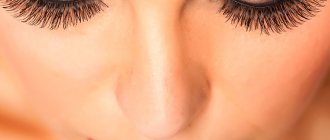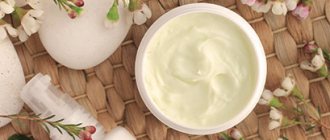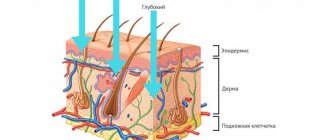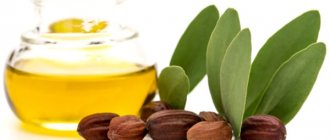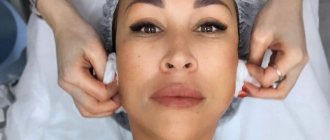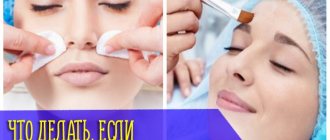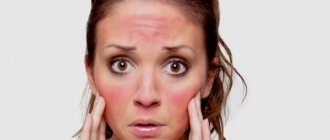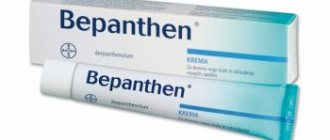The beauties of Ancient Egypt used peeling to cleanse their skin. This word is translated from English as “cleansing, removing the husks.” Cosmetologists call the process during which the top layer of dead cells, along with some living cells, is removed and exfoliated, exfoliation.
As a result, the face returns to youth, attractiveness and a healthy appearance. But in order for beauty to shine faster, the cells that are renewed and work intensively during the period after peeling need to be helped. And this is done with the help of creams and ointments.
What types of peelings are there?
Dead cells are removed by acting on one of three skin levels - this is how peelings differ in depth of penetration.
Superficial, low-traumatic peeling whitens age spots and refreshes the skin without affecting the sensitive layer. Sometimes this type of peeling is used to prepare for cleansing the middle layers of the skin.
The rejuvenating process of medium peeling encourages cell renewal, causes collagen formation and helps lymph flow. Medium peeling is used by girls from 25-27 years old, for which they prepare the skin for the procedure for 2 weeks.
The aggressive deep peeling procedure is compared to plastic surgery, which smoothes out fine and deep wrinkles, eliminates acne marks, scars and evens out the surface of the skin.
Deep peeling, which requires anesthesia, is done using hardware or chemical methods only in a cosmetology clinic.
Why do you need special skin care after peeling?
Peeling procedures end with a painstaking process of restoring the skin surfaces. Sometimes, if you neglect the recommendations given by the cosmetologist, even with complications.
During a peeling session, the skin receives physical and chemical trauma, which is manifested by active peeling, itching and redness.
The weakened tissues of the upper layer become sensitive and susceptible to all kinds of infections. Such skin cannot cope with recovery without special protection in the form of creams and ointments.
What problems will you face after peeling:
- With peeling, the strength of which is influenced by the applied composition;
- With swelling of the nose, neck, décolleté, if the skin is thin and sensitive;
- With the appearance of pimples on problem skin;
- With age spots and freckles, if there is no sun protection;
- With a rash – a manifestation of an allergic reaction;
- With scars or scars, when the crusts are removed independently.
Therefore, it is so important to choose the right care product and remember to apply it.
Why is it needed?
During any type of peeling, the hydrolipid layer of the skin is destroyed, gluing together the keratinized scales of the upper layer of the epidermis.
During mechanical cleansing (ultrasonic or microdermabrasion), part of the fat layer still remains on the skin. But after ablative laser or chemical treatment, it is completely removed. Having lost its natural protection, the skin becomes very sensitive to any negative external influences: temperature changes, wind, high humidity, ultraviolet radiation, etc. Accordingly, it is easily irritated and inflamed, which often provokes various side effects.
Therefore, post-peeling care has two main goals: additional protection and hydration. These are the ones that need to be addressed with one or more different creams.
In this case, any cosmetics will not work. You will have to choose it based on your skin type and the type of peeling performed.
What components should be contained in post-peeling products and why?
When choosing post-peeling moisturizers, it is recommended to purchase creams and ointments with substances that help the skin barrier to recover more quickly. In addition, with components that accelerate skin healing and enhance the rebirth of new cells.
And also - with antioxidants.
The basis for cream and ointment should be thermal water.
Cosmetologists advise using the following products:
with hyaluronic and fruit acids;- with amino acids and antioxidants;
- with collagen and alginates;
- with vitamins A, B, C, E, urea and lanolin;
- with natural plant extracts and oils;
- with aloe and algae extracts.
Natural components of medicinal creams and ointments relieve discomfort, moisturize and eliminate tightness. More often, such products are prescribed by a cosmetologist.
Important! You cannot use creams with silicones, parabens and artificial dyes, with fragrances and sodium sulfate laureate, with mineral oil.
Skin hydration
For the purpose of moisturizing, film-forming creams or ointments are used to prevent excessive moisture loss. This makes it possible to reduce the feeling of dryness and tightness. The most inexpensive and simple example is Vaseline. But it is better to use special cosmetics with hyaluronic acid, which acts as a powerful hydrophobic substance and retains moisture in the skin. In addition, you can perform biorevitalization and use preparations based on waxes and paraffin. For example, products from the Dr. Spiller, Algologie and so on.
General rules and recommendations for the recovery period after peeling
After going through the peeling procedure, the main thing is to moisturize and nourish the injured skin, as well as stimulate regeneration.
In addition to these recommendations, you should definitely adhere to other rules:
- Washing is allowed after 24 hours if the peeling is superficial. Medium peeling imposes such a ban for 3 days and allows only warm acidified water. Deep cleansing allows washing on the 5th day.
- Drying with a towel is not allowed; cosmetic wipes should be used to blot moisture.
- Wash with sulfate-free foams (pH 5) and lubricate the skin with medicated cream or gel.
- On the 5-6th day, apply soothing herbal compresses.
- Do not use alcohol-based products. Purchase anti-inflammatory and bactericidal ointments and creams only in pharmacies.
- Use moisturizing, nourishing creams and alginate masks (made from brown algae).
- Use sunscreen with a UV factor of at least 30.
- Applying makeup is allowed after 14-15 days. The foundation should have an anti-comedogenic effect.
- For two weeks you should not drink alcohol, salty or spicy foods, do not go to the bathhouse or sauna, do not sunbathe, and do not go to sports training.
- To restore hydrobalance, you need to drink clean water - 1.5-2 liters per day.
- If the skin condition worsens, antihistamines and antibiotics are prescribed.
- It is forbidden to use a scrub or forcefully remove a layer of crusts.
If peeling is done by a professional and proper care is taken at home, the skin will recover in a short time and complications will not appear.
Precautionary measures
In order for the exfoliation after peeling to be gentle and the skin to recover faster, only the use of creams is not enough. It is necessary to ensure that the person is treated with care and observe the following precautions for the next few days:
- do not touch your face with your hands;
- try to sleep on your back;
- do not use peelings and scrubs;
- do not do facial massage and masks;
- do not visit the sauna, swimming pool, solarium;
- do not use decorative cosmetics;
- do not sweat or engage in active sports.
If after peeling there was a frosting effect (the face was covered with a whitish crust), I advise clients to watch their facial expressions. Tight skin can easily crack, and if infection gets into the wounds, there is a high probability of inflammation developing. Already on the 3-4th day, the crust will begin to peel off on its own and you can gradually return to your usual way of life.
When can you start using creams and ointments?
After the peeling procedure, swelling, peeling, crusts are visible, the skin begins to heal.
Attention! During this period, it is allowed to use only medicinal creams and ointments with anti-inflammatory and wound-healing properties, which are recommended by a cosmetologist. During the first 7 days, cells actively divide, new fibers are formed, which requires moisture and nutrients. At this stage, it is necessary to use products that help wounds heal, soothe inflammation and soften the skin.
On the 3rd day, apply a moisturizer suitable for your skin type to your face, which is tight with dehydration. After 5-7 days, moisturizing with the help of natural masks and decoctions, and the use of nourishing cream are allowed.
Important! If peeling was done in winter, use a nourishing cream more often than a moisturizer.
Complications
If peeling is carried out by a qualified cosmetologist, complications mainly occur only in the form of minor skin discomfort. But since the procedure is quite aggressive and the skin reaction is difficult to predict, the following consequences may occur:
- exfoliation of the skin;
- redness for more than 3 weeks;
- formation of pigment spots;
- the appearance of scars;
- swelling of the skin.
The occurrence of such complications requires contacting a specialist and prescribing additional care products. If this is not possible, pharmaceutical drugs can become an emergency aid. The most popular and effective cream is Bapanten 5%. It has a wound-healing, anti-inflammatory effect. It should be applied in such an amount as to prevent the skin from drying out.
Scheme - how to properly apply cream or ointment
In order to quickly revive the skin, when applying a cosmetic product, you should follow these rules:
- Treat the skin with a toner that does not contain alcohol.
- Apply a thin and even layer of cream with gentle, slow movements, moving upwards and to the sides, and also taking into account the direction of the massage lines.
- The product is not rubbed in, but distributed gently with light superficial movements.
- When there are a lot of crusts, the cream is applied 5 times a day. Once the dead skin comes off, two times is enough.
- You will have to use sunscreen or emulsion for 2-3 months before leaving the house.
Carefully! Quick, hasty strokes cause harm to the skin - stretch and injure.
Summing up
Feedback from my clients suggests that almost any high-quality cream after cleansing the face significantly improves the condition of the skin and promotes its rapid recovery. So it is a necessary component of post-peeling care. Given my recommendations for choice, they usually stop at professional or branded products.
I would also like to say a few words for lovers of all-natural creams. They are usually oil-based, which is not very good for the first days after deep peeling. If you really don’t want to use chemicals, then before active peeling begins, apply panthenol or any light gel. And only after 2-3 days - creams.
TOP 13 creams and ointments for application after peeling
Mandatory care after exfoliation includes the application of moisturizing and soothing creams, the choice of which affects the speed of wound healing and the reduction of discomfort.
D-panthenol
Cream with dexpanthenol or provitamin B5, coenzyme.
Regenerates, heals, and copes with redness and itching in a short time.
Dexpanthenol with vitamin B5
The ointment improves cell metabolism and normalizes protection from external influences.
Compacts collagen fibers and restores tissue and water balance, helps with irritation.
Bepanten
Bepanten ointment is used after damage with medium and deep peeling. The dexpanthenol substance penetrates the tissue, becoming pantothenic acid.
The ointment is useful for accelerating regeneration, healing microcracks and eliminating irritations. Apply a thin layer with light rubbing, first 5 times, then in the morning and evening.
Solcoseryl
Solcoseryl ointment or gel is used after chemical peeling. With blood proteins from calves.
Helps saturate cells with oxygen and produce collagen, enhancing regeneration and accelerating healing. Reduces swelling and inflammation. For post-peeling care and complications with burns.
Vegefarma Cream
Vegefarma Cream is used after laser and chemical peeling. Contains rapeseed and sunflower oil, milk proteins, chamomile and fireweed flower extracts.
Antibacterial, fights inflammation, moisturizes. Used to prevent infections. Relieves redness and irritation.
Baby cream
Regular children's cream for use after superficial and medium peeling 7-10 days after the procedure.
With plant extracts and oils, natural animal fats, beeswax, silicon dioxide, kaolin and other substances. Nourishes, moisturizes, helps protect the skin during sudden temperature changes.
Traumeel
The ointment contains calendula and witch hazel, echinacea and yarrow, chamomile and daisy, arnica, St. John's wort and belladonna.
Anesthetizes, relieves inflammation, irritation and discomfort. Removes swelling with redness. Corrects complications.
Methyluracil
Methyluracil ointment is used after deep peeling or if complications arise. Protects the skin from ultraviolet radiation, promotes healing by accelerating cell regeneration. Relieves inflammation.
Hydrocortisone ointment
Hydrocortisone ointment for treatment after skin trauma by medium and deep peeling. With the hormone hydrocortisone, lanolin, pentol and stearic acid.
After applying the ointment, the skin does not itch, redness and swelling disappear. Antiallergenic agent.
Christina
Protective cream Christina with zinc oxide, shea butter, rosehip and jojoba. With carnauba wax, red clay, alaria extract, vitamins A and E and bisabolol.
Regenerates cells, protects against UV rays, eliminates rashes on oily skin. For a tonal effect. Apply to problem skin of oily and dry type.
Terra mater
Terra mater cream is used after acid peeling and mechanical cleaning. Contains centela asiatica, collagen and vitamin complex.
Moisturizes, gives calm, after which redness and acne disappear, the skin heals faster. Easily spread over cleansed skin and wait 5 minutes.
Bioderma sensibio forte
Bioderma sensibio forte (Sensibio Forte) is useful after laser peeling. With vitamin A and active natural substances.
Hypoallergenic, moisturizing, relieving irritation and inflammation. Apply day and evening to sensitive skin in case of irritation.
La Roche-Posay Hydreane
Composition of moisturizing cream for dry and very dry skin “La Roche-Posay Hydreane” with hydrolipids and glycerin, black currant oil, apricot kernels, coriander and thermal water enriched with selenium. Contains karite butter and bio oils.
Soothes, nourishes and moisturizes. Restores tissue. For dry skin, apply to face and neck twice daily.
When do you need additional SPF and how to choose it?
Sunscreen is applied to prevent pigmentation before leaving the house, because ultraviolet radiation passes through even dense clouds.
To protect the skin, a product with SPF 50 is suitable, which means that only 1% of the rays will reach the skin. This cream is used for another 2 months after the skin has healed.
3 products with SPF suitable for facial skin after peeling
The sunscreen SPF 50 “Sublime Sun” (L'Oreal Paris) contains jasmine extract and vitamin E. The product moisturizes and rejuvenates the skin, prevents the synthesis of melanin, which inhibits the appearance of hyperpigmentation.
Anti-aging cream “Medium Holy Land Age Defense” (CC Cream SPF50) consists of gingko biloba extract, vitamins E, C, citric acid, including green tea leaves. These substances accelerate regeneration, cope with inflammation and redness.
Anthelios La Roche-Posay cream is recommended for those with sensitive and irritated skin. The product reliably protects against ultraviolet radiation and softens fabrics.
Myths about post-peeling care: what you definitely shouldn’t do
There are many myths about skin care. Some of them can be dangerous even for completely healthy skin.
And after peeling, the skin is irritated and vulnerable, so you should take care of it even more carefully. Therefore, it is important not to be fooled by popular advice, and to know why they are harmful.
One of the most persistent myths is the myth about water with lemon; supposedly you need to wipe your face with water in which natural lemon juice is dissolved a week before the procedure. This is a dangerous misconception!
Lemon juice, even diluted in water, contains citric acid, which can disrupt the pH of the skin, causing irritation and even burns .
Citric acid in cosmetics is strictly controlled by the manufacturer, but home remedies containing it can be harmful.
A similar effect is caused by fresh fruit juice, which lovers of traditional medicine recommend for washing before peeling.
Peeling is a serious procedure, and there is no point in exfoliating the skin again if you are going to have professional exfoliation with products with proven effectiveness.
